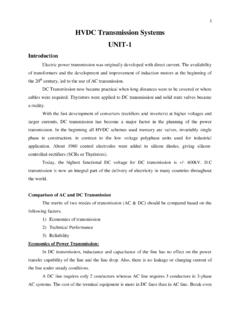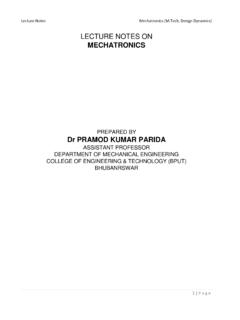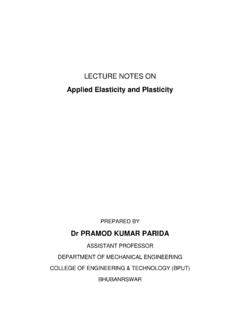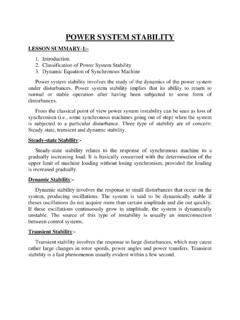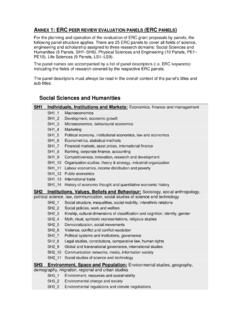Transcription of LECTURE NOTES ON
1 MODERN MANUFACTURING PROCESSES (PEME 5306)1DR , CET, BBSRLECTURE NOTES ONModern Manufacturing ProcessPREPARED BYDr PRAMOD KUMAR PARIDAASSISTANT PROFESSORDEPARTMENT OF MECHANICAL ENGINEERINGCOLLEGE OF ENGINEERING & TECHNOLOGY (BPUT)BHUBANRSWARMODERN MANUFACTURING PROCESSES (PEME 5306)2DR , CET, BBSRS yllabusModule I (12 hours) ULTRASONIC MACHINING (USM): Introduction, equipment, tool materials & tool size, abrasive slurry, cutting tool system design:- Effect of parameters on Material removal rate, tool wear, Accuracy, surface finish, applications, advantages & Disadvantages of USM. ABRASIVE JET MACHINING (AJM): Introduction, Equipment, Variables in AJM: Carrier Gas, Type of abrasive work material, stand off distance (SOD), nozzle design, shape of cut.
2 Process characteristics-Material removal rate, Nozzle wear, Accuracy & surface finish. Applications, advantages & Disadvantages of Jet Machining: Principle, Equipment, Operation, Application, Advantages and limitations of Water Jet machining. ELECTROCHEMICAL MACHINING (ECM): Introduction, study of ECM machine, elements of ECM process: ECM Process characteristics Material removal rate, Accuracy, surface finish, Applications, Electrochemical turning, Grinding, Honing, deburring, Advantages, Limitations. CHEMICAL MACHINING (CHM): Introduction, elements of process, chemical blanking process, process characteristics of CHM: material removal rate, accuracy, surface finish, Hydrogen embrittlement, advantages & application of CHM.
3 Module II (13 hours)ELECTRICAL DISCHARGE MACHINING (EDM): Introduction, mechanism of metal removal, dielectric fluid, spark generator, EDM tools (electrodes) Electrode feed control, EDM process characteristics: metal removal rate, accuracy, surface finish, Heat Affected Zone. Machine tool selection, Application, electrical discharge grinding, wire EDM. PLASMA ARC MACHINING (PAM): Introduction, equipment, non-thermal generation of plasma, selection of gas, Mechanism of metal removal, PAM parameters, process characteristics. Applications, Advantages and beam MACHINING (LBM): Introduction, equipment of LBM mechanism of metal removal, LBM parameters, Process characteristics, Applications, Advantages & beam MACHINING (EBM): Principles, equipment, operations, applications, advantages and limitation of EBM.
4 Module III (11 hours) Introduction to Surface engineering, High speed machining and grinding: Application of advanced coatings in high performance modern cutting tools and high performance super-abrasive grinding wheels, Micro and nano machining of glasses and ceramics. Theory and application of chemical processing: Chemical Machining, Aching of semi conductors, Coating and Electroless forming, PVD and CVD; Introduction to Reverse Engineering, Concurrent Engineering and Rapid prototyping: Text Books: 1. Modern machining process, Pandey and Shan, Tata McGraw Hill 2000 2. Manufacturing Engg. & Technology, Kalpakjian , Pearson Education 3.
5 Manufacturing Science, Mallik, EWP Reference Books 1. Metals Handbook: Machining Volume 16, Joseph R. Davis (Editor), American Society of Metals. 2. Surface Wear Analysis, Treatment & Prevention - ASM International, Materials Park, OH, , 1st Ed. 1995 3. Production Technology, HMT, Tata McGraw Hill. 2001 4. Modern Machining Process, Aditya. 2002 5. Non-Conventional Machining, , The Institution of Engineers (India) Test book series, Narosa Publishing House 2005. 6. Introduction to Rapid Prototyping, A Ghosh, North West PublicationMODERN MANUFACTURING PROCESSES (PEME 5306)3DR , CET, BBSRCOURSE OUTCOMESThe course is consists of all non-conventional manufacturing processes.
6 It starts with classification of manufacturing processes and necessity of non-conventional manufacturing processes. This course dealt with details about the mechanism of material removal, sources of energy used for material removal, working principle, the set up or equipment and relative advantages and disadvantages. It gives a clear cut idea about the processes, its use in specific industrial application etc. Module IModern or Non Traditional Manufacturing ProcessesModern or Non-traditional manufacturing processes is defined as a group of processes that remove excess material by various techniques involving mechanical, thermal, electrical or chemical energy or combinations of these energies but do not use a sharp cutting tools as it needs to be used for traditional manufacturing hard and brittle materials are difficult to machine by traditional machining processes such as turning, drilling, shaping and milling.
7 Non-traditional machining processes, also called advanced manufacturing processes, are employed where traditional machining processes are not feasible, satisfactory or economical due to special reasons as outlined below. Very hard fragile materials difficult to clamp for traditional machining When the workpiece is too flexible or slender When the shape of the part is too complex Several types of non-traditional machining processes have been developed to meet extra required machining conditions. When these processes are MODERN MANUFACTURING PROCESSES (PEME 5306)4DR , CET, BBSR employed properly, they offer many advantages over non-traditional machining processes.
8 The common non-traditional machining processes are described in this manufacturing processes are classified according to the type of fundamental machining energy employed. A detail classification f the machining process based on the type of energy used , the mechanism of metal removal, the source of energy requirements etc is given below:Classification of machining processesType of EnergyMechanism of Metal RemovalTransfer MediaEnergy sourceProcessesMechanicalErosionHigh velocity particlePneumatic/Hydraulic pressureAJM, USM, WJMS hearPhysical contactCutting toolConventional machiningElectro chemicalIon displacement ElectrolyteHigh currentECM, ECGC hemicalAblative relationReactive environmentCorrosive agentCHMT hermoelectricFusionHot gasesIonized materialIBM, PAME lectronsHigh voltageEDMV aporizationRadiationAmplified lightLBMIon streamIonized materialPAMAJM: Abrasive Jet MachiningCHM:Chemical machiningECG: Electrochemical GrindingECM:Electrochemical Machining EDM.
9 Electro Discharge MachiningMODERN MANUFACTURING PROCESSES (PEME 5306)5DR , CET, BBSRIBM:Ion beam MachiningLBM: laser beam MachiningPAM:Plasma Arc MachiningUSM:Ultrasonic MachiningWJM:Water Jet MachiningULTRASONIC MACHINING (USM):USM is mechanical material removal process or an abrasive process used to erode holes or cavities on hard or brittle workpiece by using shaped tools, high frequency mechanical motion and an abrasive slurry. USM offers a solution to the expanding need for machining brittle materials such as single crystals, glasses and polycrystalline ceramics, and increasing complex operations to provide intricate shapes and workpiece profiles.
10 It is therefore used extensively in machining hard and brittle materials that are difficult to machine by traditional manufacturing processes. The hard particles in slurry are accelerated toward the surface of the workpiece by a tool oscillating at a frequency up to 100 KHz - throughrepeated abrasions, the tool machines a cavity of a cross section identical to its own. A schematic representation of USM is shown in Figure 1: Schematic of ultrasonic machine toolMODERN MANUFACTURING PROCESSES (PEME 5306)6DR , CET, BBSRUSM is primarily targeted for the machining of hard and brittle materials(dielectric or conductive) such as boron carbide, ceramics, titanium carbides, rubies, quartz etc.
